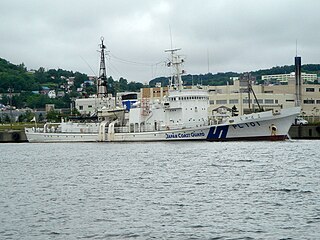
The Haruna-class destroyer was a destroyer class built for the Japan Maritime Self-Defense Force (JMSDF) in the early 1970s. These helicopter carrying destroyers (DDH) are built around a large central hangar which houses up to three helicopters.

Air-sea rescue, and aeronautical and maritime search and rescue (AMSAR) by the ICAO and IMO, is the coordinated search and rescue (SAR) of the survivors of emergency water landings as well as people who have survived the loss of their seagoing vessel. ASR can involve a wide variety of resources including seaplanes, helicopters, submarines, rescue boats and ships. Specialized equipment and techniques have been developed. Both military and civilian units can perform air-sea rescue. Its principles are laid out in the International Aeronautical and Maritime Search and Rescue Manual. The International Convention on Maritime Search and Rescue is the legal framework that applies to international air-sea rescue.

The Asagiri-class destroyer is a class of destroyer, serving with the Japan Maritime Self-Defense Force (JMSDF). It was the second class of first-generation general-purpose destroyers of the JMSDF.

USCGC Hamilton (WHEC-715) was a United States Coast Guard high endurance cutter and the lead ship of its class. It was based at Boston, Massachusetts from commissioning until 1991, then out of San Pedro, California before it was moved to its last home port in San Diego, California. It was launched on December 18, 1965 at Avondale Shipyards near New Orleans, Louisiana and named for Founding Father Alexander Hamilton, the first United States Secretary of the Treasury and founder of the United States Revenue Cutter Service. It was commissioned on March 18, 1967.

USCGC Tampa (WMEC-902) is a United States Coast Guard medium endurance cutter. She was commissioned 16 March 1984. Her motto, "Thy way is the sea, thy path in the great waters", matches the inscription that is engraved on the memorial at Arlington National Cemetery for the 131 persons lost following the sinking of a previous cutter Tampa on September 18, 1918.

United States Coast Guard Air Station Houston is a United States Coast Guard Air Station located 15 miles (24 km) southeast of downtown Houston, Texas on board the Ellington Field Joint Reserve Base (JRB).

The Shiretoko-class patrol vessel is a class of PL type patrol vessels of the Japan Coast Guard. PL stands for "Patrol vessel Large", and the class name "Shiretoko" is named after Shiretoko, the northeastern area of the island of Hokkaidō, Japan

The Shikishima-class patrol vessel is a class of PLH type patrol vessels of the Japan Coast Guard. In the official classification, Shikishima and Akitsushima are treated as the only ships in their classes, respectively; and Reimei is treated as the lead ship of her class. The Shikishima class was once the world's largest coast guard vessel until it was surpassed by the Chinese Zhaotou-class patrol cutter in 2015.

The Ojika-class patrol vessel is a class of PL type patrol vessels of the Japan Coast Guard.

The Tsugaru-class patrol vessel is a class of PLH type patrol vessels of the Japan Coast Guard.

The Mizuho-class patrol vessel is a class of PLH type patrol vessels of the Japan Coast Guard.

The Kunigami-class patrol vessel is a class of 1,000 ton-class PL type patrol vessels of the Japan Coast Guard (JCG).

The Iwami-class patrol vessel is a class of 1,000 ton-class PL type patrol vessels of the Japan Coast Guard (JCG).

The Japanese patrol boat Mizuho is a PLH type patrol vessels of the Japan Coast Guard. She is only ship in her class: the construction of a second ship was planned originally, but has not been achieved as of 2020 due to the start of construction of the Shunkō class and Reimei class.

Mizuho (PLH-21) is the lead ship of Mizuho-class patrol vessel of Japanese Coast Guard. She was renamed as Fusō in 2019.

Akitsushima (PLH-32) is a Akitsushima-class patrol vessel currently operated by the Japanese Coast Guard.

Reimei (PLH-33) is a Reimei-class patrol vessel currently operated by the Japanese Coast Guard.
Akatsuki (PLH-34) is a Reimei-class patrol vessel currently operated by the Japanese Coast Guard.

Asazuki (PLH-35) is a Reimei-class patrol vessel currently operated by the Japanese Coast Guard.























